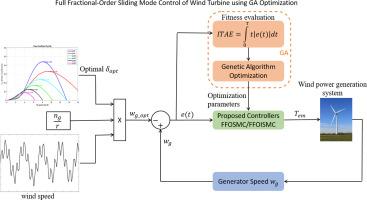Novel full fractional-order control and Lyapunov stability approach using genetic algorithm optimization for high-performance wind turbines
IF 4.9
3区 计算机科学
Q1 COMPUTER SCIENCE, HARDWARE & ARCHITECTURE
引用次数: 0
Abstract
Wind energy systems play a key role in the global shift toward renewable energy. However, effectively controlling variable-speed wind turbines (VSWTs) under fluctuating wind conditions remains challenging. This paper presents a nonlinear fractional-order control method designed for VSWTs, using a fractional-order two-mass model that captures flexible shaft dynamics at low speeds. A novel control strategy based on full fractional-order sliding mode control (FFOSMC) and full fractional-order integral sliding mode control (FFOISMC) is introduced to enhance system stability, accuracy, and robustness. The fractional-order design leverages memory and non-local effects for improved performance. To tune control parameters, an evolutionary optimization technique is applied, ensuring adaptability across operating conditions. Stability is analyzed using the fractional-order Lyapunov method. Simulation results show that the proposed method outperforms conventional approaches in tracking accuracy, torque response, and energy efficiency. This work contributes to advanced wind turbine control and supports the development of smart renewable energy systems.

基于遗传算法优化的高性能风力发电机全分数阶控制和Lyapunov稳定性新方法
风能系统在全球向可再生能源的转变中发挥着关键作用。然而,在波动风条件下有效控制变速风力涡轮机(VSWTs)仍然是一个挑战。本文提出了一种用于vswt的非线性分数阶控制方法,该方法使用分数阶双质量模型来捕获低速下柔性轴的动力学。提出了一种基于全分数阶滑模控制(FFOSMC)和全分数阶积分滑模控制(FFOISMC)的新型控制策略,以提高系统的稳定性、精度和鲁棒性。分数阶设计利用内存和非局部效应来提高性能。为了调整控制参数,采用了一种进化优化技术,以确保不同操作条件下的适应性。用分数阶Lyapunov方法分析了系统的稳定性。仿真结果表明,该方法在跟踪精度、扭矩响应和能效方面均优于传统方法。这项工作有助于先进的风力涡轮机控制,并支持智能可再生能源系统的发展。
本文章由计算机程序翻译,如有差异,请以英文原文为准。
求助全文
约1分钟内获得全文
求助全文
来源期刊

Computers & Electrical Engineering
工程技术-工程:电子与电气
CiteScore
9.20
自引率
7.00%
发文量
661
审稿时长
47 days
期刊介绍:
The impact of computers has nowhere been more revolutionary than in electrical engineering. The design, analysis, and operation of electrical and electronic systems are now dominated by computers, a transformation that has been motivated by the natural ease of interface between computers and electrical systems, and the promise of spectacular improvements in speed and efficiency.
Published since 1973, Computers & Electrical Engineering provides rapid publication of topical research into the integration of computer technology and computational techniques with electrical and electronic systems. The journal publishes papers featuring novel implementations of computers and computational techniques in areas like signal and image processing, high-performance computing, parallel processing, and communications. Special attention will be paid to papers describing innovative architectures, algorithms, and software tools.
 求助内容:
求助内容: 应助结果提醒方式:
应助结果提醒方式:


